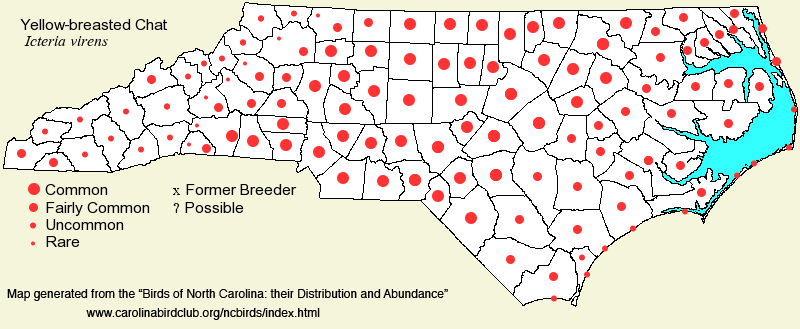 |  |
|
Yellow-breasted Chat - Icteria virens Sole representative of ICTERIIDAE in NC | Search Common: Search Scientific: |
|
|
|||||||
| General Comments | The Yellow-breasted Chat, the "emblem" of the Carolina Bird Club and the namesake of its quarterly journal -- The Chat -- is a most unusual species. Long considered as a Wood-warbler (in the genus Parulidae), a few years ago the American Ornithological Society moved the species to its own family, Icteriidae -- not to be confused with the Icteridae (the New World Blackbirds). Its odd antics and disjointed song, with "caws", "chucks", rattles, and other odd sounds and often given in flight, makes it completely unlike any other bird. It breeds from coast to coast across the United States, barely into Canada; a few winter in the southern states, but it mainly winters in the tropics. It nests in all North Carolina counties, being a "classic" old-field bird. It favors overgrown fields and clearcuts regenerating back into dense shrubs and saplings, up to about 15-20 feet high; brier patches and wide woodland ecotones with shrubbery are also used, as are some maritime thickets. In winter, it is found in similar habitats, mainly near the coast, where it typically inhabits broadleaf evergreen shrubs and small trees. | ||||||
| Breeding Status | Breeder | ||||||
| NC BRC List | Definitive | ||||||
| State Status | |||||||
| U.S. Status | |||||||
| State Rank | S5B | ||||||
| Global Rank | G5 | ||||||
| Coastal Plain | Summer resident, and scarce winter visitor/straggler. In summer, generally common across the western and central portions of the region, and fairly common in the eastern third and along the coast; it nests along the Outer Banks. In winter, rare and secretive (easily overlooked) along and close to the coast, in early winter, but very rare after Jan, though a few birds overwinter. Farther inland, very rare in early winter, but not overwintering. Mainly mid-Apr to late Oct, but dozens of records in the three winter months. Peak counts: | ||||||
| Piedmont | Summer resident, and very sparse into early winter. Fairly common to common in summer across most of the region, but fairly common in the western/foothill region. Mainly mid- or late Apr to late Sep. In winter, very rare along the eastern and southern portions into the first half of winter, but essentially absent by late winter. Quite unusual was one that spent from 10 Jan to the end of Feb 2010 at a Greensboro feeder. Peak counts: | ||||||
| Mountains | Summer resident. Uncommon to fairly common in the lower elevations, up to about 4,000 feet; rare to about 4,500 feet. Mainly late Apr to mid- or late Sep. Two winter reports: 1, Warren Wilson College (Buncombe), 10 Dec 2006; 1, Crumpler (Ashe), 11 Jan 1968. Peak counts: | ||||||
| Finding Tips |
Should be easily heard by driving country backroads in the Coastal Plain and Piedmont in May and June. *** to **** | ||||||
| Attribution | LeGrand[2023-04-02], LeGrand[2012-10-03], LeGrand[2011-12-18] | ||||||
| NC Map Map depicts all counties with a report (transient or resident) for the species. | Click on county for list of all known species. |
| NC Breeding Season Map Map depicts assumed breeding season abundance for the species. |  |